Cotton Wastes Functionalized Biomaterials from Micro to Nano: A Cleaner Approach for a Sustainable Environmental Application
Abstract
:1. Introduction
2. Environmental Impact of Cotton Wastes
2.1. Functional Properties of Cotton Fibres
2.2. Applications of Cotton Wastes
2.2.1. Environmental Applications
- Water Treatment
- Dye Removal
| Precursor | Adsorbate | Qmax (mg/g) | References |
|---|---|---|---|
| Cotton wastes | Methylene blue solution | 76.0 | [47] |
| Cotton waste | Aqueous solution of Alizarin red dye | 73.8 | [51] |
| Cotton wastes | Dissolution of Bi(NO3)35H2O in a solution of Rhodamine B and Methylene Blue | 93.7 97.04 | [43] |
| Cotton fibre | Aqueous solution of Methylene blue dye | 95.6 | [48] |
| Cotton stalk | Aqueous solution of Methylene blue | 147.06 | [50] |
| Sulphuric acid-treated cotton stalk | Aqueous solution of Methylene blue | 555.56 | [50] |
| Phosphorus acid-treated cotton stalk | Aqueous solution of Methylene blue | 222.22 | [50] |
| Cotton waste fabrics | Methylene blue and Rhodamine 6G (R6G) solution | 185.63 118.21 | [52] |
| Waste cottonseed | Basic red 2 (BR2) and solutions Basic violet 3 (BV3) | 50.11 66.69 | [46] |
| Cotton fibre | Concentration of crystal red and methylene blue | 175.1 113.1 | [53] |
| cotton hull waste CNC from cotton waste | Reactive blue, red concentration Methylene blue solution | 12.91 | [54] |
- Heavy metals removal
| Precursor | Adsorbate | Qmax (mg/g) | Reference |
|---|---|---|---|
| Waste cotton Yarn | Aqueous solution of Pb, Cd, Cr, As ions | 890.8 191.7 236.2 72.90 | [58] |
| Waste cotton fibres | Inorganic pollutants As (III) Inorganic arsenic Arsanilic acid (ASA) C6H8AsNO3 Roxarsone (Rox C6H6AsNO6) | 126.5 164 261.4 427.5 | [61] |
| Char-FeCl3 from cotton waste Char-FeCl2 from cotton waste Char-FeCit from cotton waste | Cr(VI) solution, HNO3, NaOH Concentration | 73.79 68.87 43.84 | [57] |
| Cotton hull | Pb(II) from gold mining liquid effluent | 27.65 | [56] |
| Cellulose from waste cotton fabrics | Heavy metal nitrate salts (CuNO3)2, Cd(NO3)2, and Pb(NO3)2 Cd, Cu, Pb, Fe, and Zn investigated | Cd: 99.8 Cu: 99.8 Pb: 99.7 Fe: 98.0 Zn: 99.9 | [60] |
| Cotton fibre | Aqueous solution of Cu(II) ions Aqueous solution of Pb(II) ions Aqueous solution of Cr(III) ions | 81.97 123.46 72.99 | [59] |
| Denim fibre scraps | Aqueous solution of Pb(II) Aqueous solution of Cd(II) Aqueous solution of Zn(II) Aqueous solution of As(II) | 9.83 2.71 2.69 1.23 | [62] |
| Cotton fibre | Heavy metal solution of Cu(II), Zn(II), Pb(II), and Cd(II) | 6.12 4.53 8.22 21.62 | [63] |
| Cotton fibre | Aqueous solution of Cu(II) and Pb(II) | 88.9 70.6 | [53] |
- Geotechnical applications
2.2.2. Packaging Applications
2.2.3. Biomedical Applications
- Antimicrobial Materials
- Biosensing and Diagnostic
- Tissue Engineering
3. Extraction of CNC from Cotton Wastes and Applications
3.1. Chronological Study of Cellulose Extraction from Cotton Wastes
| Source | Method of Cellulose Extraction | Reference |
|---|---|---|
| Cotton linter | Cooking cotton linter, depolymerization | [118,135] |
| Cotton wool waste | Hydrolysis using concentrated sulphuric acid | [119] |
| Cotton Waste | Sodium bisulphite concentration | [120] |
| Cotton waste | Caustic kiering method, Geiger counter spectrometer | [122,136] |
| Cotton cloth waste | Kiering bleaching method | [123] |
| Cotton waste | Graft copolymerization | [137,138] |
| Cotton waste | Enzymatic hydrolysis by compressing milling | [124] |
| Cotton linters | Ball milling | [125] |
| Cotton waste | Enzymatic hydrolysis | [126] |
| Cotton linters | Nitration, organic solvent | [128,139] |
| Cotton waste | Strains of trichoderma and Aspergillus bleaching | [127] |
| Cotton fibre waste | Alkaline hydrogen peroxide bleaching | [129] |
| Cotton fabric waste | Hydrolysis using hydrochloric acid | [130] |
| Cotton waste | Ultrasonication, hydrolysis | [127,133,134] |
3.2. Extraction of Nanocrystals from Cotton Wastes
3.3. Advanced Applications of Cotton Derived CNC
3.3.1. Biomedical Engineering
3.3.2. Packaging Applications
4. Challenges of Cotton Derived CNC and Prospects
5. Propositions for Future Research on Nanocellulose Crystals from Cotton Wastes
6. Conclusions
Author Contributions
Funding
Institutional Review Board Statement
Informed Consent Statement
Data Availability Statement
Acknowledgments
Conflicts of Interest
References
- Sandin, G.; Peters, G.M. Environmental impact of textile reuse and recycling–A review. J. Clean. Prod. 2018, 184, 353–365. [Google Scholar] [CrossRef]
- Xiao, B.; Zhang, Y.; Wang, Y.; Jiang, G.; Liang, M.; Chen, X.; Long, G. A fractal model for kozeny–carman constant and dimensionless permeability of fibrous porous media with roughened surfaces. Fractals 2019, 27, 1950116. [Google Scholar] [CrossRef]
- Ütebay, B.; Çelik, P.; Çay, A. Effects of cotton textile waste properties on recycled fibre quality. J. Clean. Prod. 2019, 222, 29–35. [Google Scholar] [CrossRef]
- Wang, Z.; Yao, Z.; Zhou, J.; Zhang, Y. Reuse of waste cotton cloth for the extraction of cellulose nanocrystals. Carbohydr. Polym. 2017, 157, 945–952. [Google Scholar] [CrossRef]
- Xiao, B.; Huang, Q.; Chen, H.; Chen, X.; Long, G. A fractal model for capillary flow through a single tortuous capillary with roughened surfaces in fibrous porous media. Fractals 2021, 29, 2150017. [Google Scholar] [CrossRef]
- Dobilaite, V.; Mileriene, G.; Juciene, M.; Saceviciene, V. Investigation of current state of pre-consumer textile waste generated at Lithuanian enterprises. Int. J. Cloth. Sci. Technol. 2017, 29, 491–502. [Google Scholar] [CrossRef]
- Rani, S.; Jamal, Z. Recycling of textiles waste for environmental protection. Int. J. Home Sci. 2018, 4, 164–168. [Google Scholar]
- Liu, W.; Liu, S.; Liu, T.; Liu, T.; Zhang, J.; Liu, H. Eco-friendly post-consumer cotton waste recycling for regenerated cellulose fibers. Carbohydr. Polym. 2019, 206, 141–148. [Google Scholar] [CrossRef] [PubMed]
- Ahmad, S.S.; Mulyadi, I.M.M.; Ibrahim, N.; Othman, A.R. The application of recycled textile and innovative spatial design strategies for a recycling centre exhibition space. Procedia Soc. Behav. Sci. 2016, 234, 525–535. [Google Scholar] [CrossRef] [Green Version]
- Aronsson, J.; Persson, A. Tearing of post-consumer cotton T-shirts and jeans of varying degree of wear. J. Eng. Fibers Fabr. 2020, 15, 1558925020901322. [Google Scholar] [CrossRef]
- Johnson, S.; Echeverria, D.; Venditti, R.; Jameel, H.; Yao, Y. Supply Chain of Waste Cotton Recycling and Reuse: A Review. Aatcc J. Res. 2020, 7, 19–31. [Google Scholar] [CrossRef]
- Rizal, S.; Alfatah, T.; Abdul Khalil, H.P.S.; Mistar, E.; Abdullah, C.; Olaiya, F.G.; Sabaruddin, F.; Muksin, U. Properties and Characterization of Lignin Nanoparticles Functionalized in Macroalgae Biopolymer Films. Nanomaterials 2021, 11, 637. [Google Scholar] [CrossRef]
- Jawaid, M.; Abdul Khalil, H.P.S. Cellulosic/synthetic fibre reinforced polymer hybrid composites: A review. Carbohydr. Polym. 2011, 86, 1–18. [Google Scholar] [CrossRef]
- Majeed, K.; Jawaid, M.; Hassan, A.; Bakar, A.A.; Abdul Khalil, H.P.S.; Salema, A.; Inuwa, I. Potential materials for food packaging from nanoclay/natural fibres filled hybrid composites. Mater. Des. 2013, 46, 391–410. [Google Scholar] [CrossRef]
- Fortunati, E.; Luzi, F.; Puglia, D.; Petrucci, R.; Kenny, J.M.; Torre, L. Processing of PLA nanocomposites with cellulose nanocrystals extracted from Posidonia oceanica waste: Innovative reuse of coastal plant. Ind. Crop. Prod. 2015, 67, 439–447. [Google Scholar] [CrossRef]
- Rizal, S.; Lai, T.K.; Muksin, U.; Olaiya, N.; Abdullah, C.; Yahya, E.B.; Chong, E.; Abdul Khalil, H.P.S. Properties of Macroalgae Biopolymer Films Reinforcement with Polysaccharide Microfibre. Polymers 2020, 12, 2554. [Google Scholar] [CrossRef]
- Sharma-Shivappa, R.; Chen, Y. Conversion of cotton wastes to bioenergy and value-added products. Trans. Asabe 2008, 51, 2239–2246. [Google Scholar] [CrossRef]
- Dai, J.; Dong, H. Intensive cotton farming technologies in China: Achievements, challenges and countermeasures. Field Crop. Res. 2014, 155, 99–110. [Google Scholar] [CrossRef] [Green Version]
- Zhang, L.; Wu, T.; Liu, S.; Jiang, S.; Wu, H.; Yang, J. Consumers’ clothing disposal behaviors in Nanjing, China. J. Clean. Prod. 2020, 276, 123184. [Google Scholar] [CrossRef]
- Ma, Y.; Rosson, L.; Wang, X.; Byrne, N. Upcycling of waste textiles into regenerated cellulose fibres: Impact of pretreatments. J. Text. Inst. 2020, 111, 630–638. [Google Scholar] [CrossRef]
- Esteve-Turrillas, F.A.; de la Guardia, M. Environmental impact of Recover cotton in textile industry. Resour. Conserv. Recycl. 2017, 116, 107–115. [Google Scholar] [CrossRef]
- Stone, C.; Windsor, F.M.; Munday, M.; Durance, I. Natural or synthetic–how global trends in textile usage threaten freshwater environments. Sci. Total Environ. 2020, 718, 134689. [Google Scholar] [CrossRef] [PubMed]
- Gordon, S.; Hsieh, Y.-l. Cotton: Science and Technology; Woodhead Publishing Ltd.: Cambridge, UK, 2006. [Google Scholar]
- Wang, H.; Farooq, A.; Memon, H. Influence of cotton fiber properties on the microstructural characteristics of mercerized fibers by regression analysis. Wood Fiber Sci. 2020, 52, 13–27. [Google Scholar] [CrossRef]
- Grishanov, S. Structure and properties of textile materials. In Handbook of Textile and Industrial Dyein; Woodhead Publishing Series in Textiles; Woodhead Publishing Limited Elsevier: Cambridge, UK, 2011; Volume 1, pp. 28–63. [Google Scholar]
- Ma, Y.; Rissanen, M.; You, X.; Moriam, K.; Hummel, M.; Sixta, H. New method for determining the degree of fibrillation of regenerated cellulose fibres. Cellulose 2020, 28, 31–44. [Google Scholar] [CrossRef]
- French, A.D.; Kim, H.J. Cotton fiber structure. In Cotton Fiber: Physics, Chemistry and Biology; Springer: Berlin/Heidelberg, Germany; Cotton Fiber Bioscience Research UnitUSDA-ARS, Southern Regional Research Center: New Orleans, LA, USA, 2018; pp. 13–39. [Google Scholar]
- Barkhotkin, Y.K. Modulus of Elasticity of the Cotton Fibres in a Yarn; Textile Industry Technology; Ivanovo State Polytechnic University: Ivanovo, Russia, 2003; Volume 3, pp. 50–53. [Google Scholar]
- Varghese, A.M.; Mittal, V. Surface modification of natural fibers. Biodegrad. Biocompatible Polym. Compos. 2018, 5, 115–155. [Google Scholar]
- Cruz, J.; Leitão, A.; Silveira, D.; Pichandi, S.; Pinto, M.; Fangueiro, R. Study of moisture absorption characteristics of cotton terry towel fabrics. Procedia Eng. 2017, 200, 389–398. [Google Scholar] [CrossRef]
- Prakash, C. Bamboo fibre. In Handbook of Natural Fibres; Woodhead Publishing Series in Textiles; Elsevier Ltd.: Cambridge, UK, 2020; Volume 1, pp. 219–229. [Google Scholar]
- Kocić, A.; Bizjak, M.; Popović, D.; Poparić, G.B.; Stanković, S.B. UV protection afforded by textile fabrics made of natural and regenerated cellulose fibres. J. Clean. Prod. 2019, 228, 1229–1237. [Google Scholar] [CrossRef]
- Gorade, V.; Chaudhary, B.; Parmaj, O.; Kale, R. Preparation and Characterization of Chitosan/viscose Rayon Filament Biocomposite. J. Nat. Fibers 2020, 1–12. [Google Scholar] [CrossRef]
- Thambiraj, S.; Shankaran, D.R. Preparation and physicochemical characterization of cellulose nanocrystals from industrial waste cotton. Appl. Surf. Sci. 2017, 412, 405–416. [Google Scholar] [CrossRef]
- Makvandi, P.; Iftekhar, S.; Pizzetti, F.; Zarepour, A.; Zare, E.N.; Ashrafizadeh, M.; Agarwal, T.; Padil, V.V.; Mohammadinejad, R.; Sillanpaa, M. Functionalization of polymers and nanomaterials for water treatment, food packaging, textile and biomedical applications: A review. Environ. Chem. Lett. 2020, 19, 1–29. [Google Scholar] [CrossRef]
- Çay, A.; Yanık, J.; Akduman, Ç.; Duman, G.; Ertaş, H. Application of textile waste derived biochars onto cotton fabric for improved performance and functional properties. J. Clean. Prod. 2020, 251, 119664. [Google Scholar] [CrossRef]
- Meng, Y.; Liu, W.; Liu, X.; Zhang, J.; Peng, M.; Zhang, T. A review on analytical methods for pharmaceutical and personal care products and their transformation products. J. Environ. Sci. 2021, 101, 260–281. [Google Scholar] [CrossRef] [PubMed]
- Sathishkumar, M.; Binupriya, A.; Kavitha, D.; Selvakumar, R.; Sheema, K.; Choi, J.; Yun, S. Organic micro-pollutant removal in liquid-phase using carbonized silk cotton hull. J. Environ. Sci. 2008, 20, 1046–1054. [Google Scholar] [CrossRef]
- Lu, S.; Liu, Q.; Han, R.; Guo, M.; Shi, J.; Song, C.; Ji, N.; Lu, X.; Ma, D. Potential applications of porous organic polymers as adsorbent for the adsorption of volatile organic compounds. J. Environ. Sci. 2021, 105, 184–203. [Google Scholar] [CrossRef]
- Czech, B.; Shirvanimoghaddam, K.; Trojanowska, E. Sorption of pharmaceuticals and personal care products (PPCPs) onto a sustainable cotton based adsorbent. Sustain. Chem. Pharm. 2020, 18, 100324. [Google Scholar] [CrossRef]
- Nayl, A.; Abd-Elhamid, A.; Abu-Saied, M.; El-Shanshory, A.A.; Soliman, H.M.; Akl, M.A.; Aly, H. A novel method for highly effective removal and determination of binary cationic dyes in aqueous media using a cotton–graphene oxide composite. RSC Adv. 2020, 10, 7791–7802. [Google Scholar] [CrossRef] [Green Version]
- Rakruam, P.; Thuptimdang, P.; Siripattanakul-Ratpukdi, S.; Phungsai, P. Molecular dissolved organic matter removal by cotton-based adsorbents and characterization using high-resolution mass spectrometry. Sci. Total Environ. 2021, 754, 142074. [Google Scholar] [CrossRef]
- Qin, Q.; Guo, R.; Lin, S.; Jiang, S.; Lan, J.; Lai, X.; Cui, C.; Xiao, H.; Zhang, Y. Waste cotton fiber/Bi 2 WO 6 composite film for dye removal. Cellulose 2019, 26, 3909–3922. [Google Scholar] [CrossRef]
- Qiu, Z.; Shu, J.; Tang, D. Near-infrared-to-ultraviolet light-mediated photoelectrochemical aptasensing platform for cancer biomarker based on core–shell NaYF4: Yb, Tm@ TiO2 upconversion microrods. Anal. Chem. 2018, 90, 1021–1028. [Google Scholar] [CrossRef]
- Song, C.; Li, H.; Yu, Y. Synthesis, microstructure transformations, and long-distance inductive effect of poly (acrylethyltrimethylammonium chloride) cotton with super-high adsorption ability for purifying dyeing wastewater. Cellulose 2019, 26, 3987–4004. [Google Scholar] [CrossRef]
- Sivarajasekar, N.; Baskar, R.; Ragu, T.; Sarika, K.; Preethi, N.; Radhika, T. Biosorption studies on waste cotton seed for cationic dyes sequestration: Equilibrium and thermodynamics. Appl. Water Sci. 2017, 7, 1987–1995. [Google Scholar] [CrossRef] [Green Version]
- Haque, A.N.M.A.; Remadevi, R.; Wang, X.; Naebe, M. Sorption properties of fabricated film from cotton gin trash. Mater. Today Proc. 2020, 31, S221–S226. [Google Scholar] [CrossRef]
- Fan, L.; Wei, C.; Xu, Q.; Xu, J. Polypyrrole-coated cotton fabrics used for removal of methylene blue from aqueous solution. J. Text. Inst. 2017, 108, 1847–1852. [Google Scholar] [CrossRef]
- Tunc, Ö.; Tanacı, H.; Aksu, Z. Potential use of cotton plant wastes for the removal of Remazol Black B reactive dye. J. Hazard. Mater. 2009, 163, 187–198. [Google Scholar] [CrossRef] [PubMed]
- Deng, H.; Lu, J.; Li, G.; Zhang, G.; Wang, X. Adsorption of methylene blue on adsorbent materials produced from cotton stalk. Chem. Eng. J. 2011, 172, 326–334. [Google Scholar] [CrossRef]
- Wanassi, B.; Hariz, I.B.; Ghimbeu, C.M.; Vaulot, C.; Hassen, M.B.; Jeguirim, M. Carbonaceous adsorbents derived from textile cotton waste for the removal of Alizarin S dye from aqueous effluent: Kinetic and equilibrium studies. Environ. Sci. Pollut. Res. 2017, 24, 10041–10055. [Google Scholar] [CrossRef]
- Tian, D.; Zhang, X.; Lu, C.; Yuan, G.; Zhang, W.; Zhou, Z. Solvent-free synthesis of carboxylate-functionalized cellulose from waste cotton fabrics for the removal of cationic dyes from aqueous solutions. Cellulose 2014, 21, 473–484. [Google Scholar] [CrossRef]
- Xiong, J.; Jiao, C.; Li, C.; Zhang, D.; Lin, H.; Chen, Y. A versatile amphiprotic cotton fiber for the removal of dyes and metal ions. Cellulose 2014, 21, 3073–3087. [Google Scholar] [CrossRef]
- Thangamani, K.; Sathishkumar, M.; Sameena, Y.; Vennilamani, N.; Kadirvelu, K.; Pattabhi, S.; Yun, S. Utilization of modified silk cotton hull waste as an adsorbent for the removal of textile dye (reactive blue MR) from aqueous solution. Bioresour. Technol. 2007, 98, 1265–1269. [Google Scholar] [CrossRef]
- Wang, Q.; Zhang, Y.; Wangjin, X.; Wang, Y.; Meng, G.; Chen, Y. The adsorption behavior of metals in aqueous solution by microplastics effected by UV radiation. J. Environ. Sci. 2020, 87, 272–280. [Google Scholar] [CrossRef]
- Yahya, M.; Yohanna, I.; Auta, M.; Obayomi, K. Remediation of Pb (II) ions from Kagara gold mining effluent using cotton hull adsorbent. Sci. Afr. 2020, 8, e00399. [Google Scholar]
- Xu, Z.; Gu, S.; Sun, Z.; Zhang, D.; Zhou, Y.; Gao, Y.; Qi, R.; Chen, W. Synthesis of char-based adsorbents from cotton textile waste assisted by iron salts at low pyrolysis temperature for Cr (VI) removal. Environ. Sci. Pollut. Res. 2020, 27, 11012–11025. [Google Scholar] [CrossRef]
- Mihajlović, S.; Vukčević, M.; Pejić, B.; Grujić, A.P.; Ristić, M. Application of waste cotton yarn as adsorbent of heavy metal ions from single and mixed solutions. Environ. Sci. Pollut. Res. 2020, 27, 35769–35781. [Google Scholar] [CrossRef] [PubMed]
- Niu, Y.; Hu, W.; Guo, M.; Wang, Y.; Jia, J.; Hu, Z. Preparation of cotton-based fibrous adsorbents for the removal of heavy metal ions. Carbohydr. Polym. 2019, 225, 115218. [Google Scholar] [CrossRef] [PubMed]
- Ma, J.; Liu, Y.; Ali, O.; Wei, Y.; Zhang, S.; Zhang, Y.; Cai, T.; Liu, C.; Luo, S. Fast adsorption of heavy metal ions by waste cotton fabrics based double network hydrogel and influencing factors insight. J. Hazard. Mater. 2018, 344, 1034–1042. [Google Scholar] [CrossRef] [PubMed]
- Pang, D.; Wang, C.-C.; Wang, P.; Liu, W.; Fu, H.; Zhao, C. Superior removal of inorganic and organic arsenic pollutants from water with MIL-88A (Fe) decorated on cotton fibers. Chemosphere 2020, 254, 126829. [Google Scholar] [CrossRef] [PubMed]
- Mendoza-Castillo, D.; Rojas-Mayorga, C.; García-Martínez, I.; Pérez-Cruz, M.; Hernández-Montoya, V.; Bonilla-Petriciolet, A.; Montes-Morán, M. Removal of heavy metals and arsenic from aqueous solution using textile wastes from denim industry. Int. J. Environ. Sci. Technol. 2015, 12, 1657–1668. [Google Scholar] [CrossRef] [Green Version]
- Paulino, Á.G.; da Cunha, A.J.; da Silva Alfaya, R.V.; da Silva Alfaya, A.A. Chemically modified natural cotton fiber: A low-cost biosorbent for the removal of the Cu (II), Zn (II), Cd (II), and Pb (II) from natural water. Desalination Water Treat. 2014, 52, 4223–4233. [Google Scholar] [CrossRef]
- Hu, E.; Shang, S.; Tao, X.-m.; Jiang, S.; Chiu, K.-l. Regeneration and reuse of highly polluting textile dyeing effluents through catalytic ozonation with carbon aerogel catalysts. J. Clean. Prod. 2016, 137, 1055–1065. [Google Scholar] [CrossRef]
- Yousef, S.; Tatariants, M.; Tichonovas, M.; Kliucininkas, L.; Lukošiūtė, S.-I.; Yan, L. Sustainable green technology for recovery of cotton fibers and polyester from textile waste. J. Clean. Prod. 2020, 254, 120078. [Google Scholar] [CrossRef]
- Echeverria, C.A.; Handoko, W.; Pahlevani, F.; Sahajwalla, V. Cascading use of textile waste for the advancement of fibre reinforced composites for building applications. J. Clean. Prod. 2019, 208, 1524–1536. [Google Scholar] [CrossRef]
- Algin, H.M.; Turgut, P. Cotton and limestone powder wastes as brick material. Constr. Build. Mater. 2008, 22, 1074–1080. [Google Scholar] [CrossRef]
- Uddin, M.M.; Karim, R.; Kaysar, M.; Dayan, M.A.R.; Islam, K.A. Low-Cost Jute-Cotton and Glass Fibre Reinforced Textile Composite Sheet. Int. J. Mat. Math. Sci 2020, 2, 1–7. [Google Scholar] [CrossRef]
- Sanivada, U.K.; Mármol, G.; Brito, F.P.; Fangueiro, R. PLA Composites Reinforced with Flax and Jute Fibers—A Review of Recent Trends, Processing Parameters and Mechanical Properties. Polymers 2020, 12, 2373. [Google Scholar] [CrossRef] [PubMed]
- Holt, G.; Chow, P.; Wanjura, J.; Pelletier, M.; Wedegaertner, T. Evaluation of thermal treatments to improve physical and mechanical properties of bio-composites made from cotton byproducts and other agricultural fibers. Ind. Crop. Prod. 2014, 52, 627–632. [Google Scholar] [CrossRef]
- Alomayri, T.; Shaikh, F.U.A.; Low, I.M. Synthesis and mechanical properties of cotton fabric reinforced geopolymer composites. Compos. Part B Eng. 2014, 60, 36–42. [Google Scholar] [CrossRef] [Green Version]
- Alomayri, T.; Shaikh, F.U.A.; Low, I.M. Characterisation of cotton fibre-reinforced geopolymer composites. Compos. Part B Eng. 2013, 50, 1–6. [Google Scholar] [CrossRef] [Green Version]
- Mahdi, E.; Dean, A. The effect of filler content on the tensile behavior of polypropylene/cotton fiber and poly (vinyl chloride)/cotton fiber composites. Materials 2020, 13, 753. [Google Scholar] [CrossRef] [PubMed] [Green Version]
- Chen, H.; Wang, F.; Chen, H.; Fang, H.; Feng, W.; Wei, Y.; Wang, F.; Su, H.; Mi, Y.; Zhou, M.; et al. Specific biotests to assess eco-toxicity of biodegradable polymer materials in soil. J. Environ. Sci. 2021, 105, 150–162. [Google Scholar] [CrossRef]
- Liu, J.-l.; Hou, T.-s.; Luo, Y.-s.; Cui, Y.-x. Experimental Study on Unconsolidated Undrained Shear Strength Characteristics of Synthetic Cotton Fiber Reinforced Soil. Geotech. Geol. Eng. 2020, 38, 1773–1783. [Google Scholar] [CrossRef]
- Sadrolodabaeea, P.; Claramunt, J.; Ardanuy, M.; de la Fuente, A. Mechanical and durability characterization of a new Textile Waste Micro-Fiber Reinforced Cement Composite for building applications. Case Stud. Constr. Mater. 2021, 14, e00492. [Google Scholar]
- Muthuraj, R.; Lacoste, C.; Lacroix, P.; Bergeret, A. Sustainable thermal insulation biocomposites from rice husk, wheat husk, wood fibers and textile waste fibers: Elaboration and performances evaluation. Ind. Crop. Prod. 2019, 135, 238–245. [Google Scholar] [CrossRef] [Green Version]
- Leal Filho, W.; Saari, U.; Fedoruk, M.; Iital, A.; Moora, H.; Klöga, M.; Voronova, V. An overview of the problems posed by plastic products and the role of extended producer responsibility in Europe. J. Clean. Prod. 2019, 214, 550–558. [Google Scholar] [CrossRef]
- Reichert, C.L.; Bugnicourt, E.; Coltelli, M.-B.; Cinelli, P.; Lazzeri, A.; Canesi, I.; Braca, F.; Martínez, B.M.; Alonso, R.; Agostinis, L. Bio-based packaging: Materials, modifications, industrial applications and sustainability. Polymers 2020, 12, 1558. [Google Scholar] [CrossRef]
- Reddy, N. Non-food industrial applications of poultry feathers. Waste Manag. 2015, 45, 91–107. [Google Scholar] [CrossRef]
- Ramamoorthy, S.K.; Skrifvars, M.; Persson, A. A review of natural fibers used in biocomposites: Plant, animal and regenerated cellulose fibers. Polym. Rev. 2015, 55, 107–162. [Google Scholar] [CrossRef]
- Montava-Jordà, S.; Torres-Giner, S.; Ferrandiz-Bou, S.; Quiles-Carrillo, L.; Montanes, N. Development of sustainable and cost-competitive injection-molded pieces of partially bio-based polyethylene terephthalate through the valorization of cotton textile waste. Int. J. Mol. Sci. 2019, 20, 1378. [Google Scholar] [CrossRef] [PubMed] [Green Version]
- Rizal, S.; Olaiya, F.G.; Saharudin, N.I.; Abdullah, C.K.; NG, O.; Mohamad Haafiz, M.K.; Yahya, E.B.; Sabaruddin, F.A.; Abdul Khalil, H.P.S. Isolation of Textile Waste Cellulose Nanofibrillated Fibre Reinforced in Polylactic Acid-Chitin Biodegradable Composite for Green Packaging Application. Polymers 2021, 13, 325. [Google Scholar] [CrossRef]
- Meekum, U.; Kingchang, P. Compounding Oil Palm Empty Fruit Bunch/Cotton Fiber Hybrid Reinforced Poly (lactic acid) Biocomposites Aiming For High-temperature Packaging Applications. BioResources 2017, 12, 4670–4689. [Google Scholar] [CrossRef] [Green Version]
- de Oliveira, S.A.; de Macedo, J.R.N.; dos Santos Rosa, D. Eco-efficiency of poly (lactic acid)-Starch-Cotton composite with high natural cotton fiber content: Environmental and functional value. J. Clean. Prod. 2019, 217, 32–41. [Google Scholar] [CrossRef]
- Hou, X.; Sun, F.; Yan, D.; Xu, H.; Dong, Z.; Li, Q.; Yang, Y. Preparation of lightweight polypropylene composites reinforced by cotton stalk fibers from combined steam flash-explosion and alkaline treatment. J. Clean. Prod. 2014, 83, 454–462. [Google Scholar] [CrossRef]
- Jummaat, F.; Yahya, E.B.; Abdul Khalil, H.P.S.; Adnan, A.; Alqadhi, A.M.; Abdullah, C.; AK, A.S.; Olaiya, N.; Abdat, M. The Role of Biopolymer-Based Materials in Obstetrics and Gynecology Applications: A Review. Polymers 2021, 13, 633. [Google Scholar] [CrossRef]
- Abdul Khalil, H.P.S.; Adnan, A.; Yahya, E.B.; Olaiya, N.; Safrida, S.; Hossain, M.; Balakrishnan, V.; Gopakumar, D.A.; Abdullah, C.; Oyekanmi, A. A Review on plant cellulose nanofibre-based aerogels for biomedical applications. Polymers 2020, 12, 1759. [Google Scholar] [CrossRef]
- Yahya, E.B.; Jummaat, F.; Amirul, A.; Adnan, A.; Olaiya, N.; Abdullah, C.; Rizal, S.; Mohamad Haafiz, M.; Abdul Khalil, H.P.S. review on revolutionary natural biopolymer-based aerogels for antibacterial delivery. Antibiotics 2020, 9, 648. [Google Scholar] [CrossRef] [PubMed]
- Tavakolian, M.; Jafari, S.M.; van de Ven, T.G. A Review on Surface-Functionalized Cellulosic Nanostructures as Biocompatible Antibacterial Materials. Nano Micro Lett. 2020, 12, 1–23. [Google Scholar] [CrossRef] [Green Version]
- Vignesh, N.; Suriyaraj, S.; Selvakumar, R.; Chandraraj, K. Facile Fabrication and Characterization of Zn Loaded Cellulose Membrane from Cotton Microdust Waste and its Antibacterial Properties—A Waste to Value Approach. J. Polym. Environ. 2021, 1–12. [Google Scholar] [CrossRef]
- Coradi, M.; Zanetti, M.; Valério, A.; de Oliveira, D.; da Silva, A.; Ulson, S.M.d.A.G.; de Souza, A.A.U. Production of antimicrobial textiles by cotton fabric functionalization and pectinolytic enzyme immobilization. Mater. Chem. Phys. 2018, 208, 28–34. [Google Scholar] [CrossRef]
- Zhang, S.; Yang, X.; Tang, B.; Yuan, L.; Wang, K.; Liu, X.; Zhu, X.; Li, J.; Ge, Z.; Chen, S. New insights into synergistic antimicrobial and antifouling cotton fabrics via dually finished with quaternary ammonium salt and zwitterionic sulfobetaine. Chem. Eng. J. 2018, 336, 123–132. [Google Scholar] [CrossRef]
- Vinod, A.; Sanjay, M.; Suchart, S.; Jyotishkumar, P. Renewable and sustainable biobased materials: An assessment on biofibers, biofilms, biopolymers and biocomposites. J. Clean. Prod. 2020, 258, 120978. [Google Scholar] [CrossRef]
- Dassanayake, R.S.; Wansapura, P.T.; Tran, P.; Hamood, A.; Abidi, N. Cotton Cellulose-CdTe Quantum Dots Composite Films with Inhibition of Biofilm-Forming S. aureus. Fibers 2019, 7, 57. [Google Scholar] [CrossRef] [Green Version]
- Jabra-Rizk, M.; Meiller, T.; James, C.; Shirtliff, M. Effect of farnesol on Staphylococcus aureus biofilm formation and antimicrobial susceptibility. Antimicrob. Agents Chemother. 2006, 50, 1463–1469. [Google Scholar] [CrossRef] [Green Version]
- Gadkari, R.; Ali, S.W.; Joshi, M.; Rajendran, S.; Das, A.; Alagirusamy, R. Leveraging antibacterial efficacy of silver loaded chitosan nanoparticles on layer-by-layer self-assembled coated cotton fabric. Int. J. Biol. Macromol. 2020, 162, 548–560. [Google Scholar] [CrossRef] [PubMed]
- Wang, Y.; Yin, M.; Li, Z.; Liu, Y.; Ren, X.; Huang, T.-S. Preparation of antimicrobial and hemostatic cotton with modified mesoporous particles for biomedical applications. Colloids Surf. B Biointerfaces 2018, 165, 199–206. [Google Scholar] [CrossRef] [PubMed]
- Bastos, A.R.; da Silva, L.P.; Gomes, V.P.; Lopes, P.E.; Rodrigues, L.C.; Reis, R.L.; Correlo, V.M.; Souto, A.P. Electroactive polyamide/cotton fabrics for biomedical applications. Org. Electron. 2020, 77, 105401. [Google Scholar] [CrossRef]
- Idumah, C.I. Influence of nanotechnology in polymeric textiles, applications, and fight against COVID-19. J. Text. Inst. 2020, 1–21. [Google Scholar] [CrossRef]
- Subbiah, D.K.; Mani, G.K.; Babu, K.J.; Das, A.; Rayappan, J.B.B. Nanostructured ZnO on cotton fabrics–A novel flexible gas sensor & UV filter. J. Clean. Prod. 2018, 194, 372–382. [Google Scholar]
- Khattab, T.A.; Fouda, M.M.; Abdelrahman, M.S.; Othman, S.I.; Bin-Jumah, M.; Alqaraawi, M.A.; Al Fassam, H.; Allam, A.A. Co-encapsulation of enzyme and tricyanofuran hydrazone into alginate microcapsules incorporated onto cotton fabric as a biosensor for colorimetric recognition of urea. React. Funct. Polym. 2019, 142, 199–206. [Google Scholar] [CrossRef]
- Edwards, J.V.; Fontenot, K.R.; Liebner, F.; Condon, B.D. Peptide-Cellulose Conjugates on Cotton-Based Materials Have Protease Sensor/Sequestrant Activity. Sensors 2018, 18, 2334. [Google Scholar] [CrossRef] [PubMed] [Green Version]
- Abdelrahman, M.S.; Fouda, M.M.; Ajarem, J.S.; Maodaa, S.N.; Allam, A.A.; Khattab, T.A. Development of colorimetric cotton swab using molecular switching hydrazone probe in calcium alginate. J. Mol. Struct. 2020, 1216, 128301. [Google Scholar] [CrossRef]
- Song, Y.; Xu, W.; Rong, M.; Zhang, M. A sunlight self-healable fibrous flexible pressure sensor based on electrically conductive composite wool yarns. Express Polym. Lett. 2020, 14, 1089–1104. [Google Scholar] [CrossRef]
- King, M.W.; Chen, J.; Deshpande, M.; He, T.; Ramakrishna, H.; Xie, Y.; Zhang, F.; Zhao, F. Structural Design, Fabrication and Evaluation of Resorbable Fiber-Based Tissue Engineering Scaffolds. Biotechnol. Bioeng. 2019, 61–188. [Google Scholar] [CrossRef] [Green Version]
- Jun, I.; Han, H.-S.; Edwards, J.R.; Jeon, H. Electrospun Fibrous Scaffolds for Tissue Engineering: Viewpoints on Architecture and Fabrication. Int. J. Mol. Sci. 2018, 19, 745. [Google Scholar] [CrossRef] [PubMed] [Green Version]
- Singh, S.; Dutt, D.; Mishra, N.C. Cotton pulp for bone tissue engineering. J. Biomater. Sci. Polym. Ed. 2020, 31, 2094–2113. [Google Scholar] [CrossRef] [PubMed]
- Khalil, H.; Jummaat, F.; Yahya, E.B.; Olaiya, N.; Adnan, A.; Abdat, M.; NAM, N.; Halim, A.S.; Kumar, U.; Bairwan, R. A review on micro-to nanocellulose biopolymer scaffold forming for tissue engineering applications. Polymers 2020, 12, 2043. [Google Scholar] [CrossRef] [PubMed]
- Xu, Y.; Wu, P.; Feng, P.; Guo, W.; Yang, W.; Shuai, C. Interfacial reinforcement in a poly-l-lactic acid/mesoporous bioactive glass scaffold via polydopamine. Colloids Surf. B Biointerfaces 2018, 170, 45–53. [Google Scholar] [CrossRef]
- Nelson, M.; Tallia, F.; Page, S.J.; Hanna, J.V.; Fujita, Y.; Obata, A.; Kasuga, T.; Jones, J.R. Electrospun cotton–wool-like silica/gelatin hybrids with covalent coupling. J. Sol-Gel Sci. Technol. 2021, 97, 11–26. [Google Scholar] [CrossRef]
- Liu, F.; Liao, X.; Liu, C.; Li, M.; Chen, Y.; Shao, W.; Weng, K.; Li, F.; Ou, K.; He, J. Poly (l-lactide-co-caprolactone)/tussah silk fibroin nanofiber vascular scaffolds with small diameter fabricated by core-spun electrospinning technology. J. Mater. Sci. 2020, 55, 7106–7119. [Google Scholar] [CrossRef]
- Reddy, N.; Yang, Y. Properties and potential applications of natural cellulose fibers from the bark of cotton stalks. Bioresour. Technol. 2009, 100, 3563–3569. [Google Scholar] [CrossRef]
- Martins, M.A.; Teixeira, E.M.; Corrêa, A.C.; Ferreira, M.; Mattoso, L.H.C. Extraction and characterization of cellulose whiskers from commercial cotton fibers. J. Mater. Sci. 2011, 46, 7858–7864. [Google Scholar] [CrossRef]
- Phanthong, P.; Reubroycharoen, P.; Hao, X.; Xu, G.; Abudula, A.; Guan, G. Nanocellulose: Extraction and application. Carbon Resour. Convers. 2018, 1, 32–43. [Google Scholar] [CrossRef]
- Jiang, S.; Xia, Z.; Farooq, A.; Zhang, M.; Li, M.; Liu, L. Efficient recovery of the dyed cotton–polyester fabric: Cellulose nanocrystal extraction and its application in composite films. Cellulose 2021, 1–14. [Google Scholar] [CrossRef]
- Endes, C.; Mueller, S.; Kinnear, C.; Vanhecke, D.; Foster, E.J.; Petri-Fink, A.; Weder, C.; Clift, M.J.D.; Rothen-Rutishauser, B. Fate of Cellulose Nanocrystal Aerosols Deposited on the Lung Cell Surface In Vitro. Biomacromolecules 2015, 16, 1267–1275. [Google Scholar] [CrossRef] [PubMed] [Green Version]
- Talbot, K.W. Process for the Extraction of Cellulose Fibers from Lignified Fibrous Material. U.S. Patent 26,404,339, 28 April 1942. [Google Scholar]
- Speakman, J. Present And Future Methods Of Separating Textile Fibres. J. Text. Inst. Proc. 1950, 41, P202–P207. [Google Scholar] [CrossRef]
- Masselli, J.W.; Burford, M.G. Pollution Reduction in Cotton Finishing Wastes Through Process Chemical Changes. Sew. Ind. Wastes 1954, 26, 1109–1116. [Google Scholar]
- Kramar, A.D.; Obradović, B.M.; Vesel, A.; Kuraica, M.M.; Kostić, M.M. Surface cleaning of raw cotton fibers with atmospheric pressure air plasma. Cellulose 2018, 25, 4199–4209. [Google Scholar] [CrossRef]
- Masselli, J.W. A Simplification of Textile Waste Survey and Treatment; Wesleyan University (Middletown, Conn.) Hall Laboratory of Chemistry, New England Interstate Water Pollution Control Commission: Boston, MA, USA, 1959; p. 68. [Google Scholar]
- Gallagher, G.T.; Elliott, E.J. Process of Alkaline Scouring and Peroxide Bleaching of Gray Cotton Cloth. U.S. Patent 3,148,019, 8 September 1964. [Google Scholar]
- Tassinari, T.; Macy, C.; Spano, L.; Ryu, D.D. Energy requirements and process design considerations in compression-milling pretreatment of cellulosic wastes for enzymatic hydrolysis. Biotechnol. Bioeng. 1980, 22, 1689–1705. [Google Scholar] [CrossRef]
- Maciel, G.E.; Kolodziejski, W.L.; Bertran, M.S.; Dale, B.E. Carbon-13 NMR and order in cellulose. Macromolecules 1982, 15, 686–687. [Google Scholar] [CrossRef]
- Bertran, M.S.; Dale, B.E. Enzymatic hydrolysis and recrystallization behavior of initially amorphous cellulose. Biotechnol. Bioeng. 1985, 27, 177–181. [Google Scholar] [CrossRef]
- Mokeev, A.; Iljin, V.; Gradova, N. Biotechnological degradation of the radioactive cellulose containing waste. J. Mol. Catal. B Enzym. 1998, 5, 441–445. [Google Scholar] [CrossRef]
- Ludwig, M.; Fengel, D. Influence of the degree of substitution and pretreatments on the surface structure of cellulose nitrate fibres. Wood Sci. Technol. 1992, 26, 393–401. [Google Scholar] [CrossRef]
- Brooks, R.E.; Moore, S.B. Alkaline hydrogen peroxide bleaching of cellulose. Cellulose 2000, 7, 263–286. [Google Scholar] [CrossRef]
- Elazzouzi-Hafraoui, S.; Nishiyama, Y.; Putaux, J.-L.; Heux, L.; Dubreuil, F.; Rochas, C. The shape and size distribution of crystalline nanoparticles prepared by acid hydrolysis of native cellulose. Biomacromolecules 2008, 9, 57–65. [Google Scholar] [CrossRef]
- Kuo, C.H.; Lin, P.J.; Lee, C.K. Enzymatic saccharification of dissolution pretreated waste cellulosic fabrics for bacterial cellulose production by Gluconacetobacter xylinus. J. Chem. Technol. Biotechnol. 2010, 85, 1346–1352. [Google Scholar] [CrossRef]
- Wu, F.; Zhang, Y.; Liu, L.; Yao, J. Synthesis and characterization of a novel cellulose-g-poly (acrylic acid-co-acrylamide) superabsorbent composite based on flax yarn waste. Carbohydr. Polym. 2012, 87, 2519–2525. [Google Scholar] [CrossRef]
- Bidgoli, H.; Zamani, A.; Jeihanipour, A.; Taherzadeh, M.J. Preparation of carboxymethyl cellulose superabsorbents from waste textiles. Fibers Polym. 2014, 15, 431–436. [Google Scholar] [CrossRef]
- Pandi, N.; Sonawane, S.H.; Kishore, K.A. Synthesis of cellulose nanocrystals (CNCs) from cotton using ultrasound-assisted acid hydrolysis. Ultrason. Sonochemistry 2020, 70, 105353. [Google Scholar] [CrossRef]
- Bartell, F.; Cowling, H. Depolymermiation of cellulose in viscose production. Ind. Eng. Chem. 1942, 34, 607–612. [Google Scholar] [CrossRef]
- Wakelin, J.H.; Virgin, H.S.; Crystal, E. Development and comparison of two X-ray methods for determining the crystallinity of cotton cellulose. J. Appl. Phys. 1959, 30, 1654–1662. [Google Scholar] [CrossRef]
- Calamari, T.A., Jr.; Schreiber, S.P.; Cooper, A.S., Jr.; Reeves, W.A. Liquid Ammonia Modification of Cellulose in Cotton and Polyester/Cotton Textiles. Text. Chem. Colorist 1971, 3, 10. [Google Scholar]
- Hebeish, A.; Kantouch, A.; El-Rafie, M. Graft copolymerization of vinyl monomers with modified cotton. II. Grafting of acrylonitrile and methyl methacrylate on acetylated cotton. J. Appl. Polym. Sci. 1971, 15, 11–24. [Google Scholar]
- Buschle-Diller, G.; Zeronian, S. Enhancing the reactivity and strength of cotton fibers. J. Appl. Polym. Sci. 1992, 45, 967–979. [Google Scholar] [CrossRef]
- Bahloul, A.; Kassab, Z.; El Bouchti, M.; Hannache, H.; Oumam, M.; El Achaby, M. Micro-and nano-structures of cellulose from eggplant plant (Solanum melongena L) agricultural residue. Carbohydr. Polym. 2020, 253, 117311. [Google Scholar] [CrossRef] [PubMed]
- Zhong, T.; Dhandapani, R.; Liang, D.; Wang, J.; Wolcott, M.P.; Van Fossen, D.; Liu, H. Nanocellulose from recycled indigo-dyed denim fabric and its application in composite films. Carbohydr. Polym. 2020, 240, 116283. [Google Scholar] [CrossRef] [PubMed]
- Abdul Khalil, H.P.S.; Davoudpour, Y.; Islam, M.N.; Mustapha, A.; Sudesh, K.; Dungani, R.; Jawaid, M. Production and modification of nanofibrillated cellulose using various mechanical processes: A review. Carbohydr. Polym. 2014, 99, 649–665. [Google Scholar] [CrossRef] [PubMed]
- Maciel, M.M.Á.D.; de Carvalho Benini, K.C.C.; Voorwald, H.J.C.; Cioffi, M.O.H. Obtainment and characterization of nanocellulose from an unwoven industrial textile cotton waste: Effect of acid hydrolysis conditions. Int. J. Biol. Macromol. 2019, 126, 496–506. [Google Scholar] [CrossRef]
- Kalia, S.; Thakur, K.; Celli, A.; Kiechel, M.A.; Schauer, C.L. Surface modification of plant fibers using environment friendly methods for their application in polymer composites, textile industry and antimicrobial activities: A review. J. Environ. Chem. Eng. 2013, 1, 97–112. [Google Scholar] [CrossRef]
- Flauzino Neto, W.P.; Mariano, M.; da Silva, I.S.V.; Silvério, H.A.; Putaux, J.-L.; Otaguro, H.; Pasquini, D.; Dufresne, A. Mechanical properties of natural rubber nanocomposites reinforced with high aspect ratio cellulose nanocrystals isolated from soy hulls. Carbohydr. Polym. 2016, 153, 143–152. [Google Scholar] [CrossRef] [PubMed]
- Kassab, Z.; Kassem, I.; Hannache, H.; Bouhfid, R.; El Achaby, M. Tomato plant residue as new renewable source for cellulose production: Extraction of cellulose nanocrystals with different surface functionalities. Cellulose 2020, 27, 4287–4303. [Google Scholar] [CrossRef]
- Hemmati, F.; Jafari, S.M.; Taheri, R.A. Optimization of homogenization-sonication technique for the production of cellulose nanocrystals from cotton linter. Int. J. Biol. Macromol. 2019, 137, 374–381. [Google Scholar] [CrossRef]
- Culsum, N.T.U.; Melinda, C.; Leman, I.; Wibowo, A.; Budhi, Y.W. Isolation and characterization of cellulose nanocrystals (CNCs) from industrial denim waste using ammonium persulfate. Mater. Today Commun. 2020, 101817. [Google Scholar] [CrossRef]
- Prado, K.S.; Gonzales, D.; Spinacé, M.A. Recycling of viscose yarn waste through one-step extraction of nanocellulose. Int. J. Biol. Macromol. 2019, 136, 729–737. [Google Scholar] [CrossRef] [PubMed]
- Wang, Z.; Yao, Z.; Zhou, J.; He, M.; Jiang, Q.; Li, A.; Li, S.; Liu, M.; Luo, S.; Zhang, D. Improvement of polylactic acid film properties through the addition of cellulose nanocrystals isolated from waste cotton cloth. Int. J. Biol. Macromol. 2019, 129, 878–886. [Google Scholar] [CrossRef] [PubMed]
- Ibarra-Díaz, N.; Castañón-Rodríguez, J.; Gómez-Rodríguez, J.; Aguilar-Uscanga, M. Optimization of peroxide-alkaline pretreatment and enzymatic hydrolysis of barley straw (Hordeum vulgare L.) to produce fermentable sugars using a Box–Behnken design. Biomass Convers. Biorefinery 2020, 1–10. [Google Scholar] [CrossRef]
- Ilyas, R.; Sapuan, S.; Atikah, M.; Asyraf, M.; Rafiqah, S.A.; Aisyah, H.; Nurazzi, N.M.; Norrrahim, M. Effect of hydrolysis time on the morphological, physical, chemical, and thermal behavior of sugar palm nanocrystalline cellulose (Arenga pinnata (Wurmb.) Merr). Text. Res. J. 2021, 91, 152–167. [Google Scholar] [CrossRef]
- Jordan, J.H.; Easson, M.W.; Dien, B.; Thompson, S.; Condon, B.D. Extraction and characterization of nanocellulose crystals from cotton gin motes and cotton gin waste. Cellulose 2019, 26, 5959–5979. [Google Scholar] [CrossRef]
- Meyabadi, T.F.; Dadashian, F.; Sadeghi, G.M.M.; Asl, H.E.Z. Spherical cellulose nanoparticles preparation from waste cotton using a green method. Powder Technol. 2014, 261, 232–240. [Google Scholar] [CrossRef]
- Yue, Y.; Zhou, C.; French, A.D.; Xia, G.; Han, G.; Wang, Q.; Wu, Q. Comparative properties of cellulose nano-crystals from native and mercerized cotton fibers. Cellulose 2012, 19, 1173–1187. [Google Scholar] [CrossRef]
- Morais, J.P.S.; de Freitas Rosa, M.; Nascimento, L.D.; do Nascimento, D.M.; Cassales, A.R. Extraction and characterization of nanocellulose structures from raw cotton linter. Carbohydr. Polym. 2013, 91, 229–235. [Google Scholar] [CrossRef] [Green Version]
- Digaitis, R.; Thybring, E.E.; Thygesen, L.G. Investigating the role of mechanics in lignocellulosic biomass degradation during hydrolysis: Part II. Biotechnol. Prog. 2021, 37, 3083. [Google Scholar] [CrossRef]
- Jordan, J.H.; Easson, M.W.; Thompson, S.; Wu, Q.; Condon, B.D. Lignin-containing cellulose nanofibers with gradient lignin content obtained from cotton gin motes and cotton gin trash. Cellulose 2021, 28, 757–773. [Google Scholar] [CrossRef]
- Johar, N.; Ahmad, I.; Dufresne, A. Extraction, preparation and characterization of cellulose fibres and nanocrystals from rice husk. Ind. Crop. Prod. 2012, 37, 93–99. [Google Scholar] [CrossRef]
- Sunasee, R.; Hemraz, U.D.; Ckless, K. Cellulose nanocrystals: A versatile nanoplatform for emerging biomedical applications. Expert Opin. Drug Deliv. 2016, 13, 1243–1256. [Google Scholar] [CrossRef] [PubMed]
- Hu, H.; Yuan, W.; Liu, F.-S.; Cheng, G.; Xu, F.-J.; Ma, J. Redox-Responsive Polycation-Functionalized Cotton Cellulose Nanocrystals for Effective Cancer Treatment. ACS Appl. Mater. Interfaces 2015, 7, 8942–8951. [Google Scholar] [CrossRef] [PubMed]
- Grishkewich, N.; Mohammed, N.; Tang, J.; Tam, K.C. Recent advances in the application of cellulose nanocrystals. Curr. Opin. Colloid Interface Sci. 2017, 29, 32–45. [Google Scholar] [CrossRef]
- Bhowmik, S.; Islam, J.M.M.; Debnath, T.; Miah, M.Y.; Bhattacharjee, S.; Khan, M.A. Reinforcement of Gelatin-Based Nanofilled Polymer Biocomposite by Crystalline Cellulose from Cotton for Advanced Wound Dressing Applications. Polymers 2017, 9, 222. [Google Scholar] [CrossRef] [PubMed] [Green Version]
- Mascheroni, E.; Rampazzo, R.; Ortenzi, M.A.; Piva, G.; Bonetti, S.; Piergiovanni, L. Comparison of cellulose nanocrystals obtained by sulfuric acid hydrolysis and ammonium persulfate, to be used as coating on flexible food-packaging materials. Cellulose 2016, 23, 779–793. [Google Scholar] [CrossRef] [Green Version]
- Li, F.; Biagioni, P.; Bollani, M.; Maccagnan, A.; Piergiovanni, L. Multi-functional coating of cellulose nanocrystals for flexible packaging applications. Cellulose 2013, 20, 2491–2504. [Google Scholar] [CrossRef] [Green Version]
- Claramunt, J.; Ventura, H.; Fernández-Carrasco, L.J.; Ardanuy, M. Tensile and flexural properties of cement composites reinforced with flax nonwoven fabrics. Materials 2017, 10, 215. [Google Scholar] [CrossRef] [Green Version]
- Masmoudi, F.; Bessadok, A.; Dammak, M.; Jaziri, M.; Ammar, E. Biodegradable packaging materials conception based on starch and polylactic acid (PLA) reinforced with cellulose. Environ. Sci. Pollut. Res. 2016, 23, 20904–20914. [Google Scholar] [CrossRef]

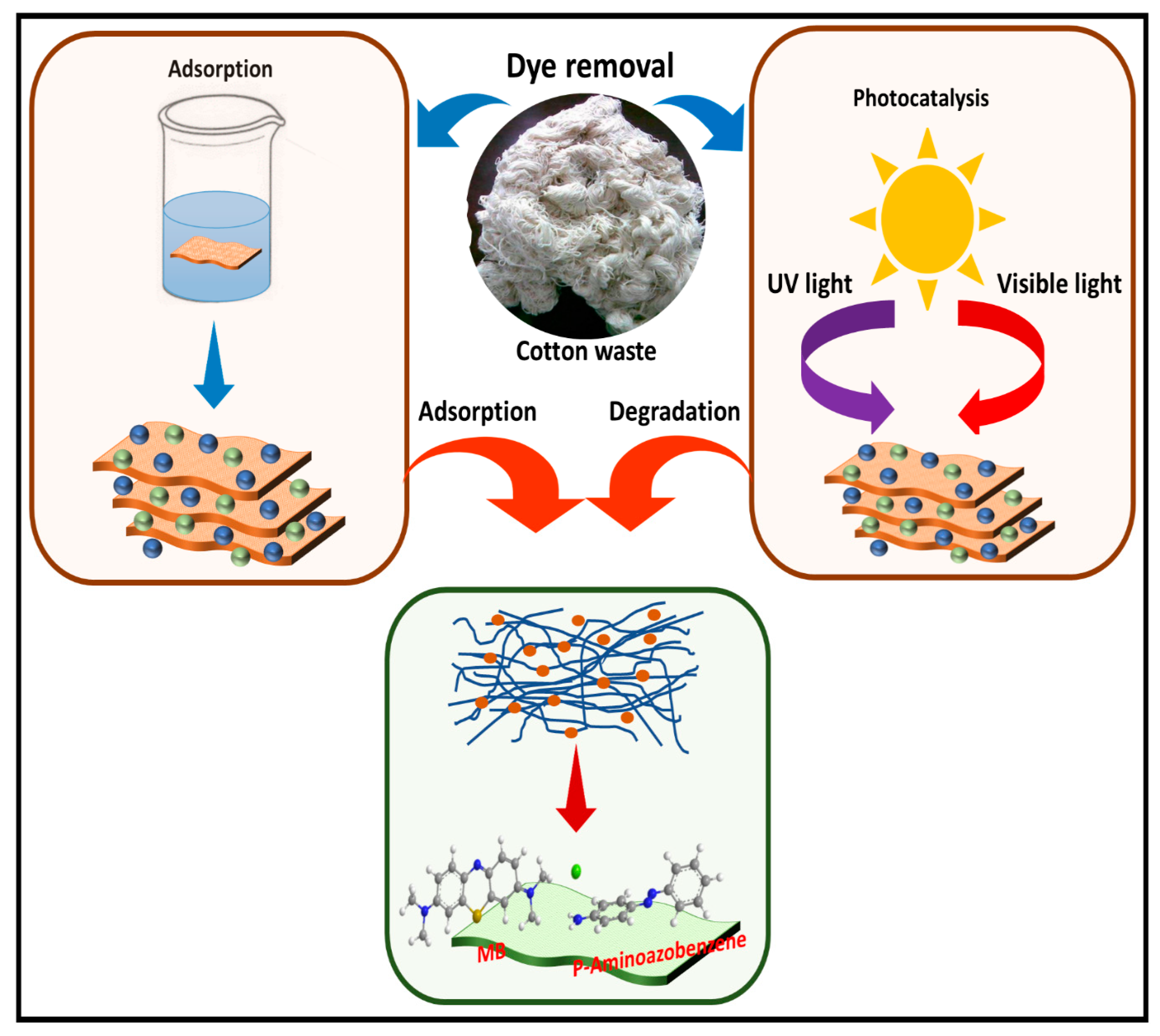
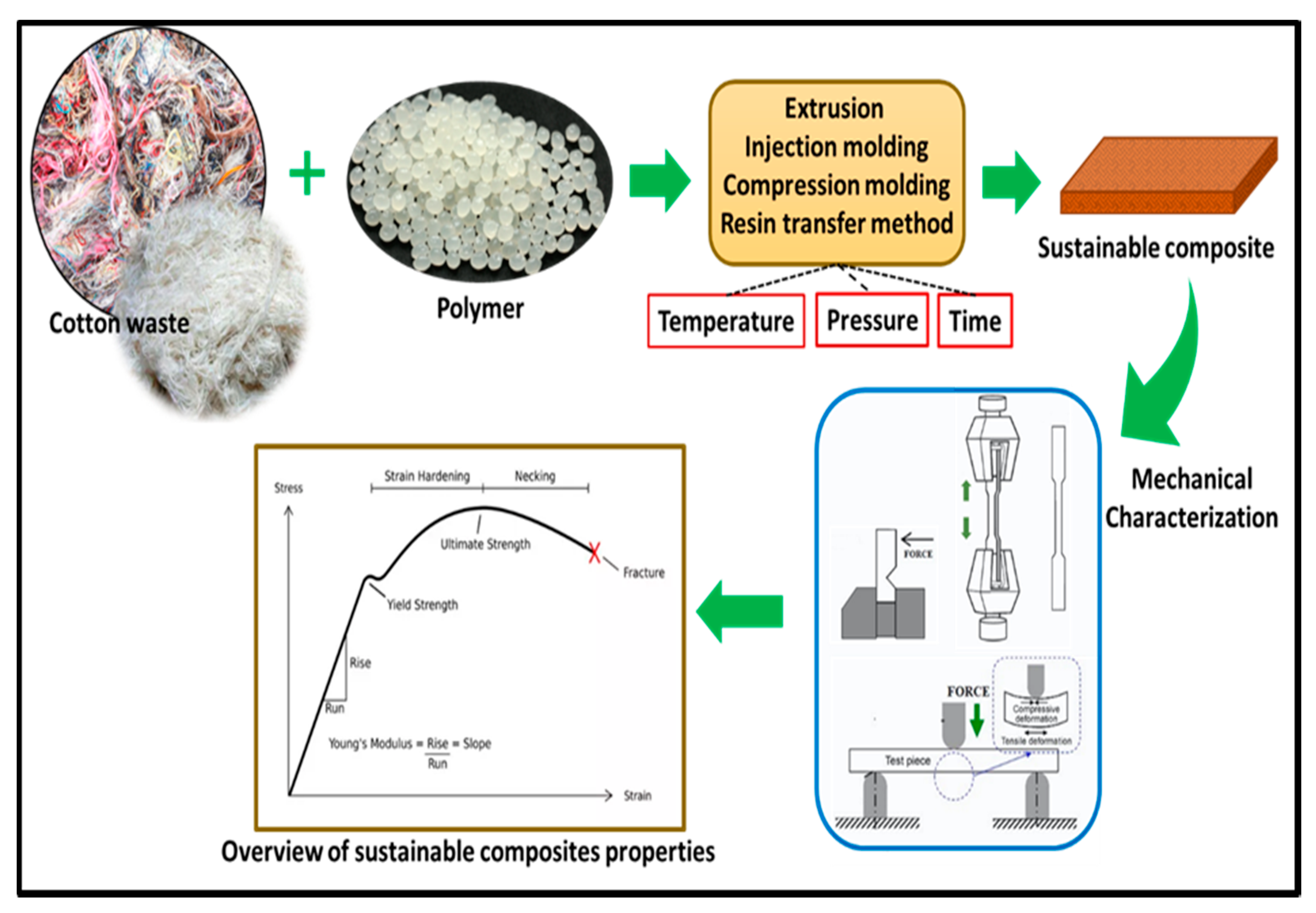
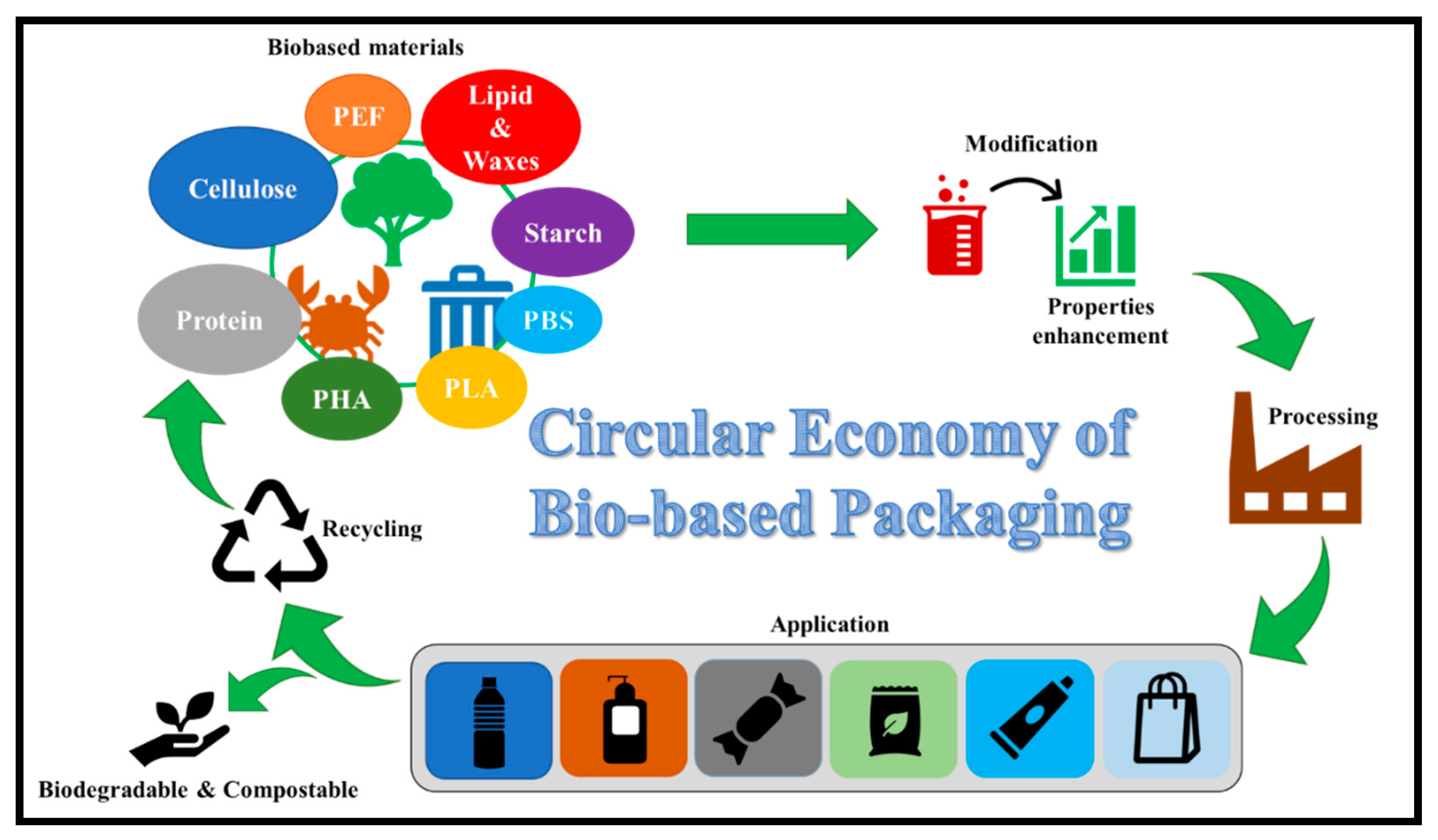
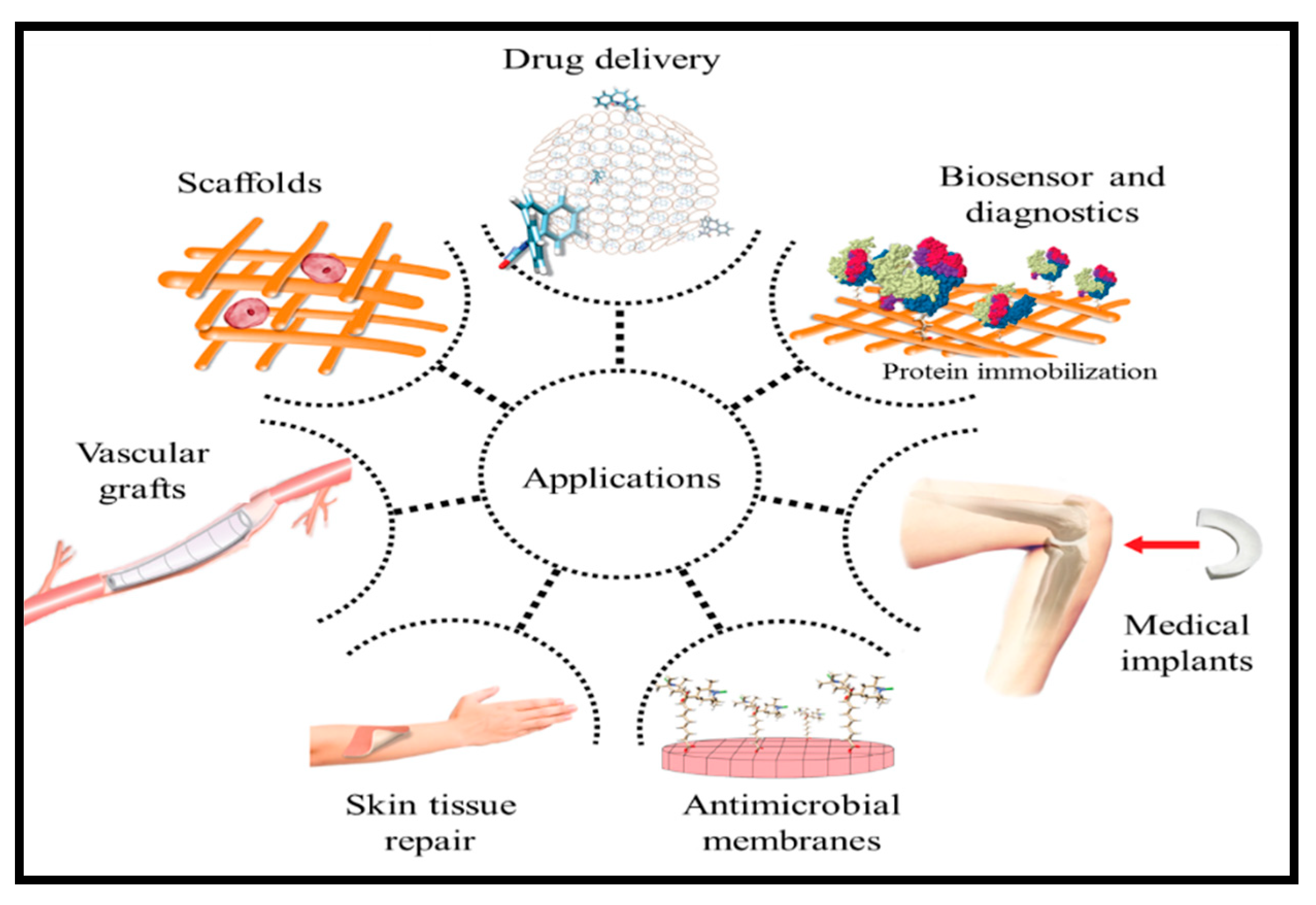


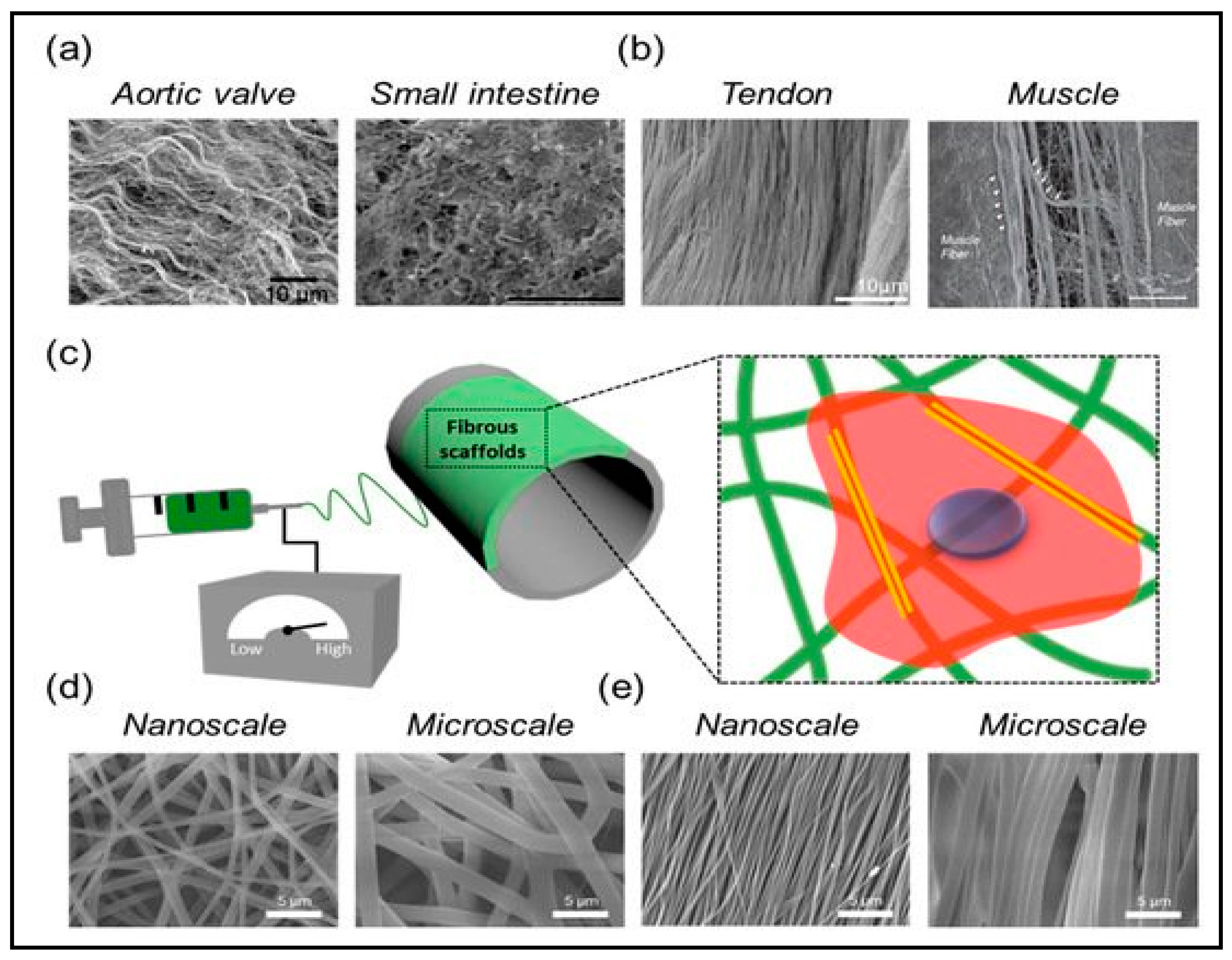
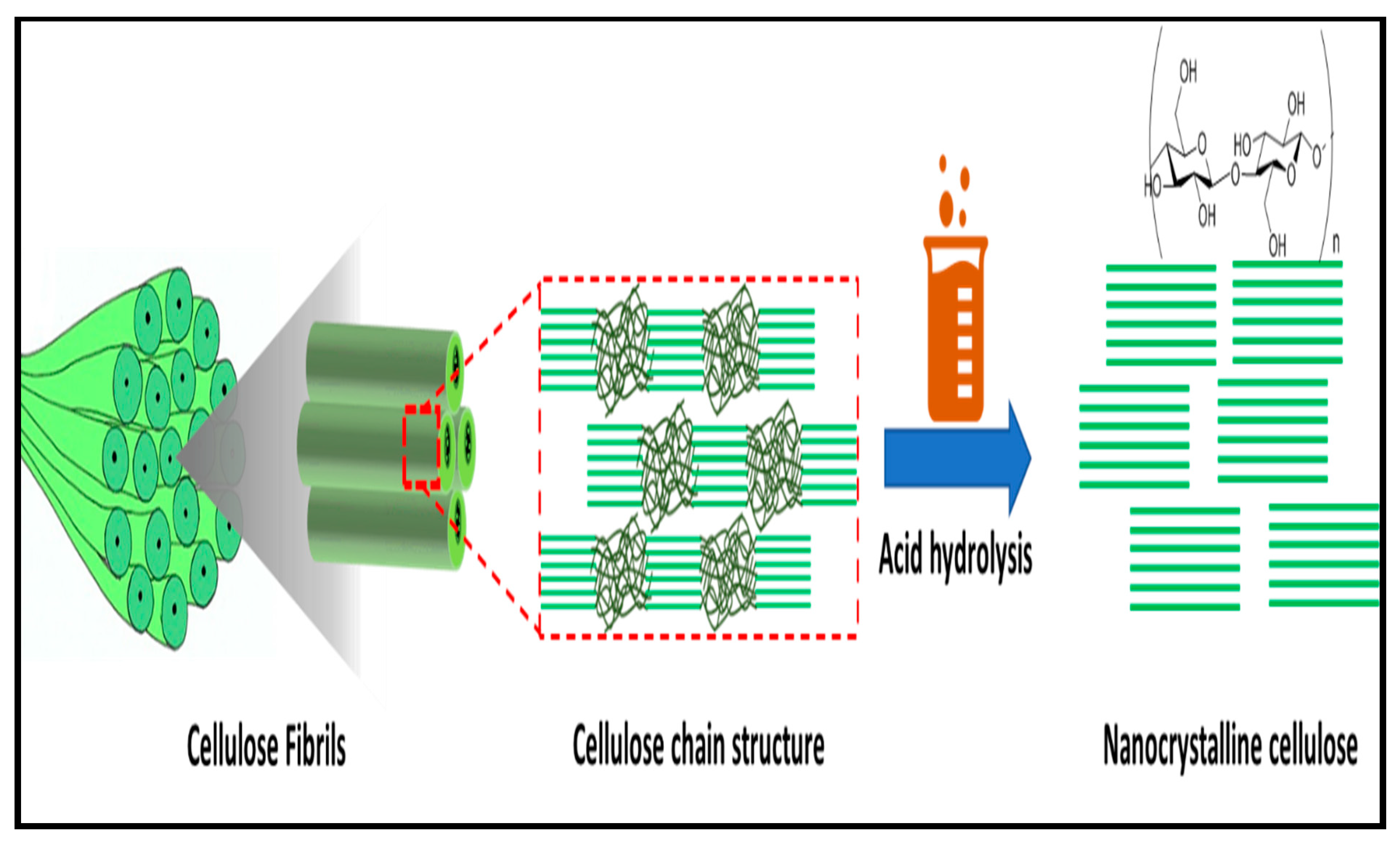


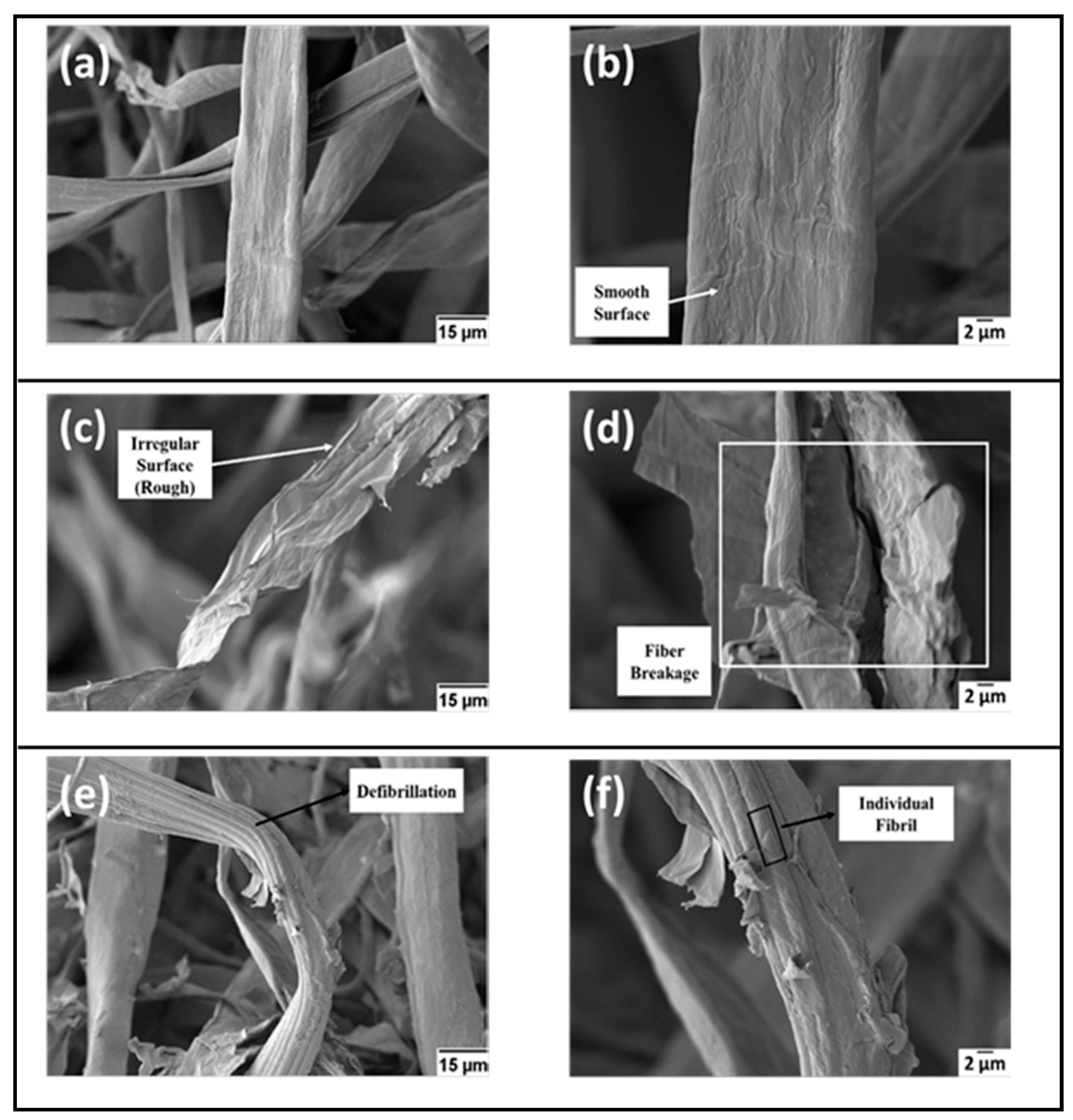
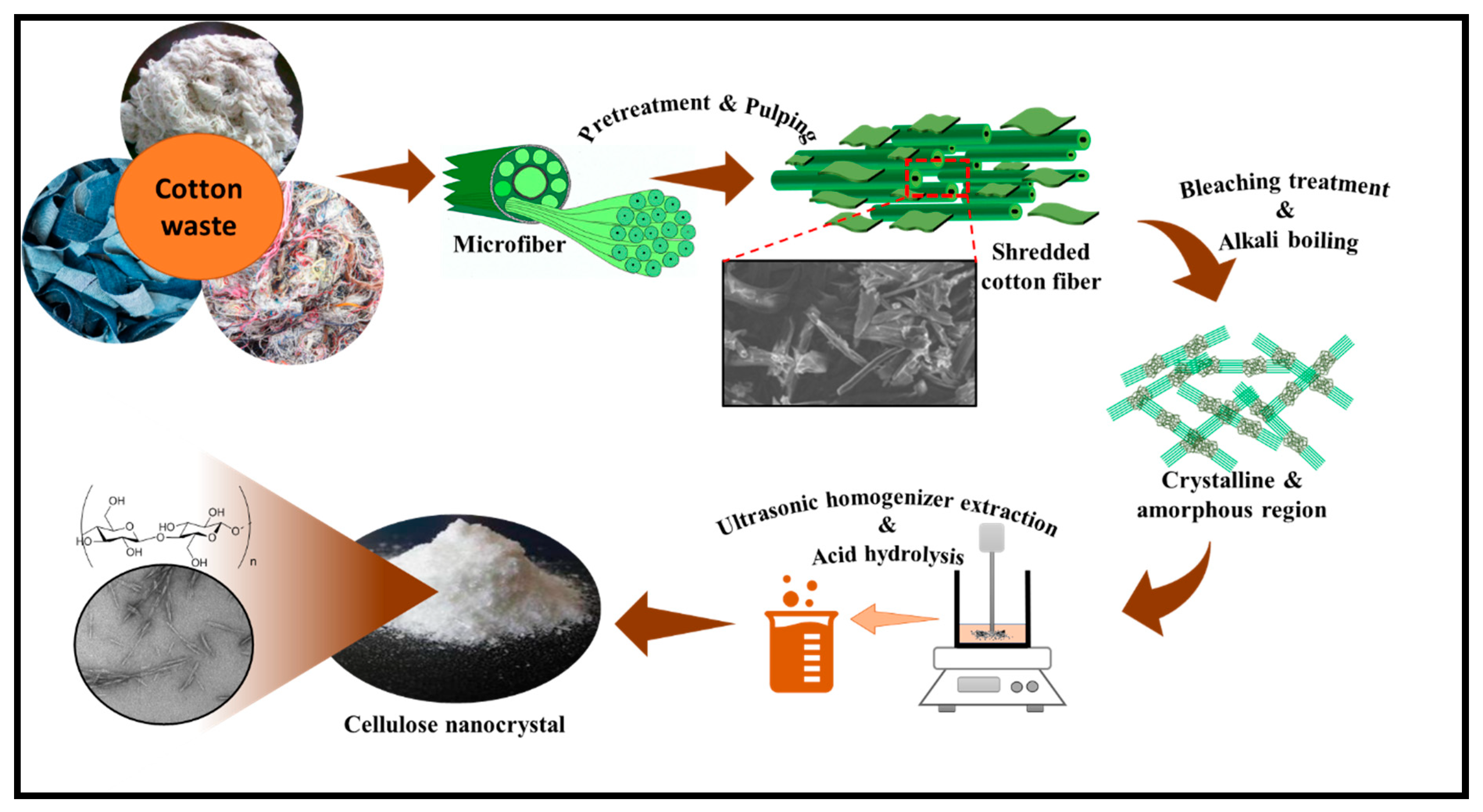
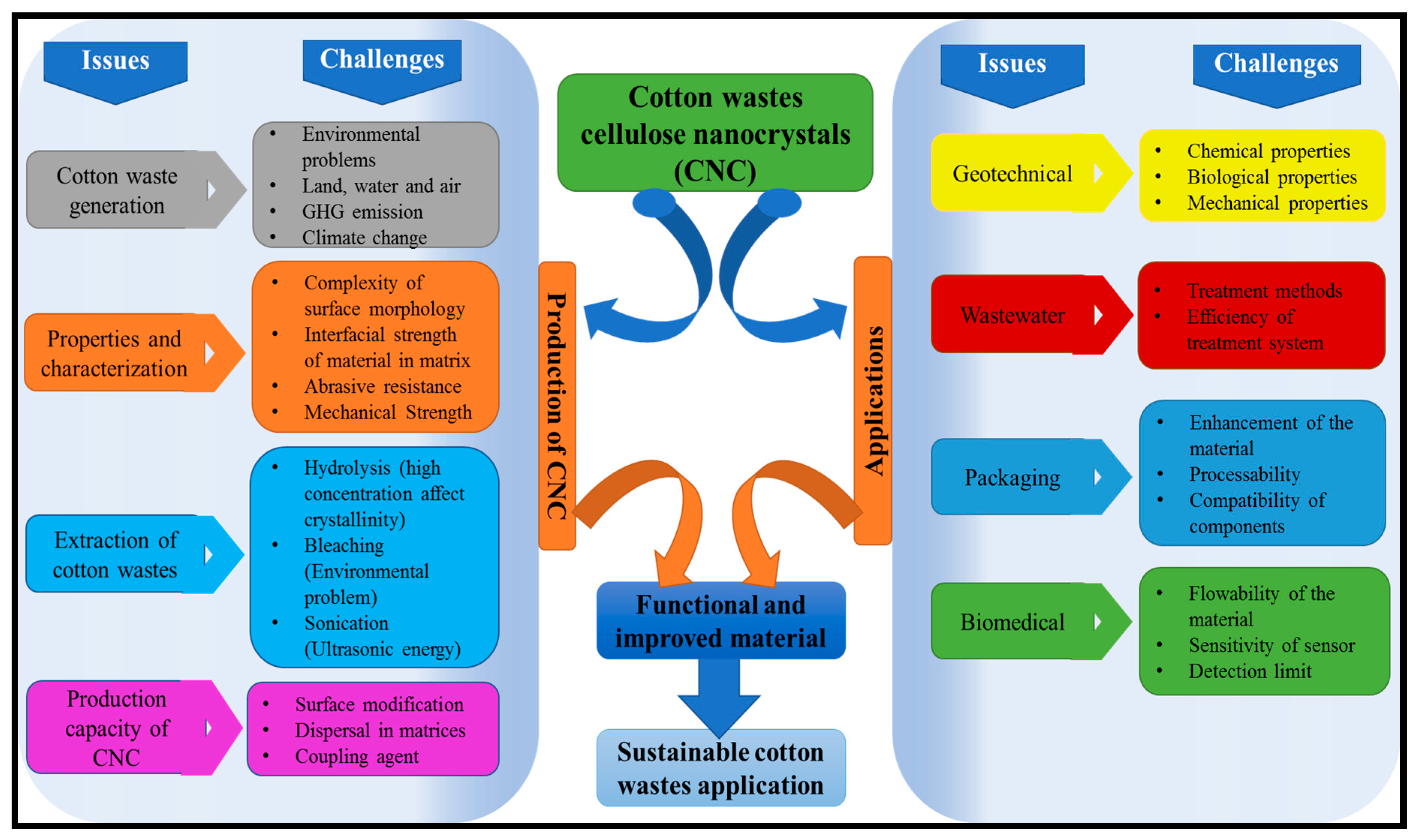
| Sources | Pretreatment Methods | Process Condition | Average Size of CNC | Advantages | Disadvantages | Reference |
|---|---|---|---|---|---|---|
| Waste cotton cloth | Alkaline treatment and acid hydrolysis | Alkali treatment 10% (wt%) of NaOH for 2 h Hydrolysis: H2SO4 and HCl at 55 °C for 7 h using ultrasonic waves | Length 28 to 470 nm Diameter: 35 nm | High crystallinity of CNC. | Low thermal stability compared to raw material | [4] |
| Cotton wastes | Acid hydrolysis | Hydrolysis: 60% H2SO4 at 50 °C for 8 h | Diameter: 6.5 nm Length: 180 ± 60 nm | Unique fluorescence properties for bioimaging and biosensing applications | Energy time consumption to determine fluorescence property | [34] |
| Waste cotton cloth | Alkali treatment and acid hydrolysis | Alkali treatment NaOH at 70 °C for 2 h Hydrolysis: H2SO4, HCl, at 65 °C for 5 h | Length: 38 nm to 424 nm Diameter: 2 to 17 nm | Smooth and dense surface with high crystallinity | Excess CNC will inhibit the formation of the transparent film in composite | [150] |
| Cotton waste | Bleaching, acid hydrolysis, and sonication | Bleaching at 60 °C for 4 h using NaOCl Hydrolysis: H2SO4 (30–50%) for 4 h Sonication: Ultrasound probe sonication for 45 min | Length: 20–100 nm Diameter: 10–50 nm | High thermal stability than the raw material | The combined effect of hydrolysis and ultrasound treatment is expensive | [134] |
| Cotton wastes | Alkali treatment, bleaching, and acid hydrolysis | Alkali treatment: NaOH solution for 1 h at 70 °C. Bleaching: Added H2O2 NaOH for 1 h at 50 °C Hydrolysis: H2SO4 at 50 °C. Pulp: Solution of 1:20 (g/mL) | Length: 105–5880 nm Diameter 23.8 ± 5.6 | Effective removal of amorphous compounds before hydrolysis | Increase in reaction time not feasible at 15 min due to an increase in processing cost | [143] |
| Indigo Denim fabrics | Bleaching and acid hydrolysis | Bleaching cotton fabrics using cotton selection mill Hydrolysis: H2SO4 at 45 °C for 1 h | Length: 197 Diameter: 7 | High crystallinity and thermal stability | Sulphuric acid hydrolysis could not degrade indigo dyes | [141] |
| Source | Size Width (nm) | Length (nm) | Crystallinity Index (%) | Yield (%) | Reference |
|---|---|---|---|---|---|
| Cotton waste | 221 | 20–100 | 81.23 | 45 | [134] |
| Denim waste | 80–120 | 76.14 ± 8.56 | 86 | 24.14 | [148] |
| Cotton fibre from denim fabrics | 11.9 ± 6.7 | 127.7 ± 43.8 | 86.4 | 39.6 | [141] |
| Cotton gin motes and cotton gin wastes | 78–247 | 100–300 | 78 | 29.3–48.6 | [153] |
| Cotton waste | - | 105–5880 | 75–81 | 80–89 | [143] |
| Cotton linter | 133 | 229 ± 97 | 82 | 59 | [147] |
| Cotton waste | 10 ± 1 | 180 ± 60 | - | 45 | [34] |
| Waste cotton cloth | - | 28–470 | 55.76 ± 7.82 | 46.7 ± 1.8 | [150] |
| Cotton waste | 40–90 | 70–200 | 82.80 | 25.21 | [154] |
| Cotton waste | - | 76–159 | 79. | 30–35 | [155] |
Publisher’s Note: MDPI stays neutral with regard to jurisdictional claims in published maps and institutional affiliations. |
© 2021 by the authors. Licensee MDPI, Basel, Switzerland. This article is an open access article distributed under the terms and conditions of the Creative Commons Attribution (CC BY) license (http://creativecommons.org/licenses/by/4.0/).
Share and Cite
Rizal, S.; H. P. S., A.K.; Oyekanmi, A.A.; Gideon, O.N.; Abdullah, C.K.; Yahya, E.B.; Alfatah, T.; Sabaruddin, F.A.; Rahman, A.A. Cotton Wastes Functionalized Biomaterials from Micro to Nano: A Cleaner Approach for a Sustainable Environmental Application. Polymers 2021, 13, 1006. https://0-doi-org.brum.beds.ac.uk/10.3390/polym13071006
Rizal S, H. P. S. AK, Oyekanmi AA, Gideon ON, Abdullah CK, Yahya EB, Alfatah T, Sabaruddin FA, Rahman AA. Cotton Wastes Functionalized Biomaterials from Micro to Nano: A Cleaner Approach for a Sustainable Environmental Application. Polymers. 2021; 13(7):1006. https://0-doi-org.brum.beds.ac.uk/10.3390/polym13071006
Chicago/Turabian StyleRizal, Samsul, Abdul Khalil H. P. S., Adeleke A. Oyekanmi, Olaiya N. Gideon, Che K. Abdullah, Esam B. Yahya, Tata Alfatah, Fatimah A. Sabaruddin, and Azhar A. Rahman. 2021. "Cotton Wastes Functionalized Biomaterials from Micro to Nano: A Cleaner Approach for a Sustainable Environmental Application" Polymers 13, no. 7: 1006. https://0-doi-org.brum.beds.ac.uk/10.3390/polym13071006








